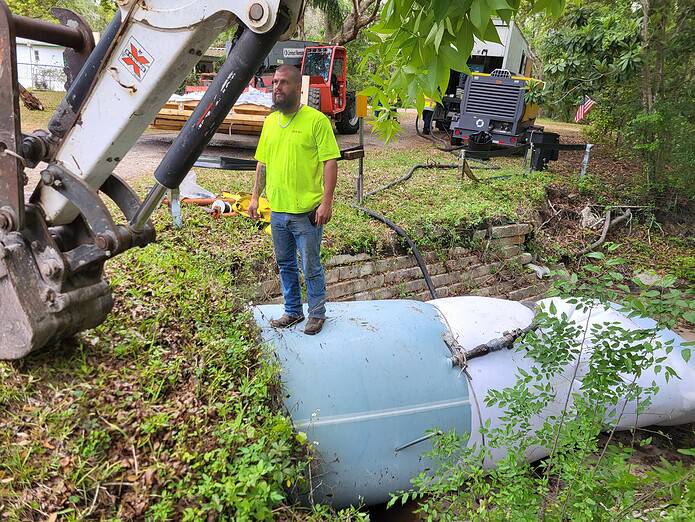A few weeks ago, my wife woke me up and told me that we had a bunch of trucks and large machinery, setting up to do work on our main culvert-type bridge leading onto our property. Now I had a feeling that I knew (somewhat) that they would be coming out to take care of a failing steel culvert pipe, but then again, we had been promised that the county would fix our pipe about every other year, for the last 15 years. About 6 weeks prior to the actual work crews coming out, there was a man from a company called Vortex Services taking measurements of the pipe and the surrounding creek layout.
On the big day, I introduced myself to the crew and they told me that they could install a hardened resin jacket to completely encase the old rusted-out steel structure.
Some of you may be wondering why I am bothering you all with a repair job. Here is my answer. There are hundreds of miles of back roads that our county has to maintain, and most of them have differing drainage “challenges” that need to be addressed. As there are so many culverts and bridges to be dealt with, there are probably just as many rural residents who are affected by these structures. It is for this demographic that I spend time on a brief description.
Ever since the Southern Hills Resort golf community was put in upstream from us, we have been experiencing more stormwater flooding instances. The 5-foot diameter pipe and the surrounding cement and earth bridge were bordering on being dangerous. Then, to add insult to injury, last year, a Pasco District Schools bus driver got lost, and just kept taking the wrong roads until she ended up parking the front of her full-sized bus halfway over the bridge leading onto our compound.
So it was a big deal that work would be getting done to fix this lingering issue. I also spoke with the foreman of the job. His name was John Clendenney, and their crew was from the Tampa Bay district. He gave me a quick rundown on what they were going to do and then, as promised, I got out of his way! What was really cool (literally) was that the resin-filled insert was brought in by refrigerated truck and when its pallet was unloaded from an 8-foot by 10-foot pallet, the thing was surrounded with at least 20 to 30 bags of ice! The crew then lowered the “bag” down into the creek (which had the water rerouted with a big pump) and then it was dragged through the old 5-foot pipe by a track hoe excavator and rope!
They then started filling the bag with pressurized steam so that it fit tightly to the old pipe. That hot air injection was no quick deal. Once the bag was filled, the pressure and heat stayed on for a good 5 hours straight. Once the resin hardened, they took battery-powered saws and cut the ends of the bag off! The finished product was a hardened shell interior about 3 inches thick.
So, as we are halfway through the months between monsoon seasons, those of you readers in the rural corners of Hernando County, keep this story in mind (just in case)! And don’t give up hope that the county roads department will help you in your time of need.
Sometimes, “pipe dreams” do come true!

